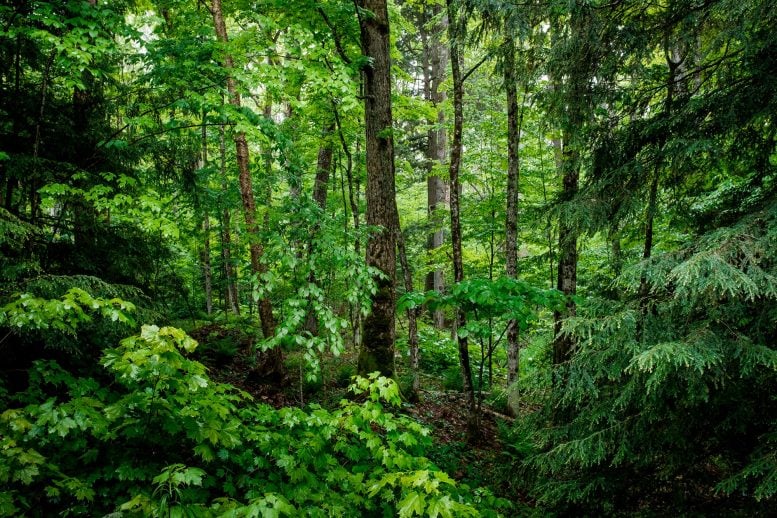
Mature forests are critical in the fight against climate change – extracting carbon dioxide (CO2) from the atmosphere and locking it into new wood.
In a groundbreaking study, researchers demonstrated that older trees can significantly increase woody biomass production in response to elevated CO2 levels, challenging previous beliefs about mature forests. The findings, derived from the BIFoR FACE experiment, underscore the potential of mature forests to act as medium-term carbon sinks and contribute to climate change mitigation, highlighting the necessity for sustained forest management and policy support.
Researchers discovered that older trees responded to increased atmospheric levels of CO2 by increasing production of woody biomass – countering existing theories that mature woodland has no capacity to respond to elevated CO2 levels.
The experts found exposure to elevated levels of the greenhouse gas (ambient atmosphere + 150 parts per million CO2; about a 40% increase) increased wood production by an average of 9.8% over a seven-year period. No corresponding increase in production of material such as leaves or fine roots, which release CO2 into the atmosphere relatively quickly, could be detected.
Long-Term Carbon Storage in Forests
Their findings published today (August 12) in the journal Nature Climate Change, support the role of mature forests as medium-term (decades-long) carbon stores and natural climate solutions – thanks to data from the long-running free-air CO2 enrichment (FACE) experiment at the University of Birmingham’s Institute of Forest Research (BIFoR), in central England.
Researchers at BIFoR established a FACE experiment in a 180-year-old deciduous woodland dominated by 26-m tall English (or ‘pedunculate’) oak trees – six 30-meter diameter plots, three exposed to elevated CO2 with the other three plots acting as a control.
Role of Mature Forests in Carbon Sequestration
Lead author Professor Richard Norby, from the University of Birmingham, commented: “Our findings refute the notion that older, mature forests cannot respond to rising levels of atmospheric CO2, but how they respond will likely depend on the supply of nutrients from the soil.
“Evidence from BIFoR FACE of a significant increase in woody biomass production supports the role of mature, long-established, forests as natural climate solutions in the coming decades while society strives to reduce its dependency on carbon.”
Future Implications for Forest Management
FACE experiments mimic future atmospheric composition and provided valuable data on interaction between forests, atmosphere, and climate. Previous experiments found that forest productivity can increase under elevated CO2 but were conducted in young tree plantations – raising questions about whether older trees would respond in the same way.
Co-author and BIFoR Director Professor Rob MacKenzie, from the University of Birmingham, commented: “We believe these results, at about the halfway point of our fifteen-year experiment at BIFoR FACE, will prove invaluable for policymakers around the globe as they grapple with the complexities of climate change.
“FACE experiments such as ours provide foundations for predictions of future atmospheric CO2 concentrations and so greatly improve confidence in policy decisions. But even if the increase in tree growth translates to a medium-term increase in carbon storage in forests, this in no way offers a reason to delay reductions in fossil fuel consumption.”
The BIFoR FACE experiment began changing the atmosphere around the forest in 2017 and measured the effect of elevated CO2 on wood production by using laser scanning to convert measured tree diameters into wood mass.
Broader Context of Forest Carbon Storage
Scientists calculated the overall growth of the forest (called net primary productivity, NPP) by combining wood production of the oaks and understory trees with the production of leaves, fine roots, flowers, and seeds, and even the amount of biologically active compounds roots released from roots.
Researchers found that NPP was 9.7% and 11.5% larger in elevated CO2 than in ambient conditions in 2021 and 2022, respectively – an increase of some 1.7 tonnes of dry matter per hectare per year. Most of this increase was due to wood production and there was no change in fine-root or leaf mass production.
To put this extra forest carbon storage in context, it is equivalent, over a hectare and over a year, to 1% of the CO2 emitted by a single commercial passenger aircraft flying one-way London to New York. The whole amount of the carbon taken up by the long-established forest per hectare per year is ten time larger. These values give some indication of the scale of forest protection and management required to offset even essential fossil-fuel emissions.
The BIFoR FACE experiment will continue into the 2030s to analyze long-term responses and the interactions between forest carbon, other plant nutrients, and the forest food web.
Reference: “Enhanced woody biomass production in a mature temperate forest under elevated CO2” by Richard J. Norby, Neil J. Loader, Carolina Mayoral, Sami Ullah, Giulio Curioni, Andy R. Smith, Michaela K. Reay, Klaske van Wijngaarden, Muhammad Shoaib Amjad, Deanne Brettle, Martha E. Crockatt, Gael Denny, Robert T. Grzesik, R. Liz Hamilton, Kris M. Hart, Iain P. Hartley, Alan G. Jones, Angeliki Kourmouli, Joshua R. Larsen, Zongbo Shi, Rick M. Thomas and A. Robert MacKenzie, 12 August 2024, Nature Climate Change.
DOI: 10.1038/s41558-024-02090-3
2 Comments
This is not groundbreaking. It has been known for decades and is pretty obvious – after water CO2 is the major thing a plant needs – so increasing the concentration is likely to be useful. The deserts fringes are greening because of all the extra CO2 – why is this almost never heard in the media? There are some disadvantages with a gently warming climate but there are plenty of big advantages so we need a more mature discussion about CO2, and scientists should refrain from being ideologist.
Good work–confirming what non-global-warming-hysterics have known for decades.